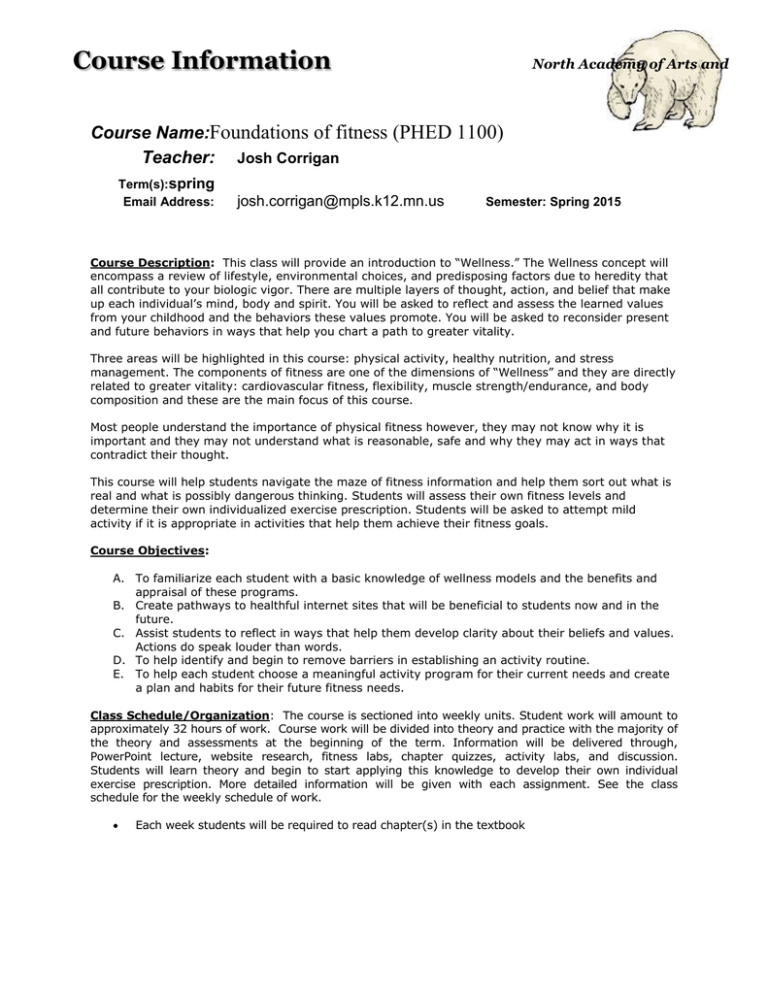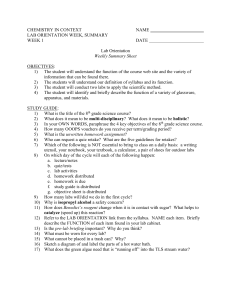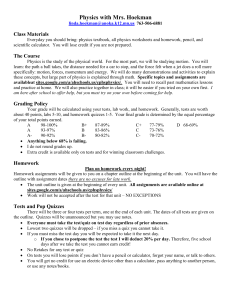Foundations of Fitness
advertisement

Course Information North Academy of Arts and Course Name:Foundations of fitness (PHED 1100) Teacher: Josh Corrigan Term(s):spring Email Address: josh.corrigan@mpls.k12.mn.us Semester: Spring 2015 Course Description: This class will provide an introduction to “Wellness.” The Wellness concept will encompass a review of lifestyle, environmental choices, and predisposing factors due to heredity that all contribute to your biologic vigor. There are multiple layers of thought, action, and belief that make up each individual’s mind, body and spirit. You will be asked to reflect and assess the learned values from your childhood and the behaviors these values promote. You will be asked to reconsider present and future behaviors in ways that help you chart a path to greater vitality. Three areas will be highlighted in this course: physical activity, healthy nutrition, and stress management. The components of fitness are one of the dimensions of “Wellness” and they are directly related to greater vitality: cardiovascular fitness, flexibility, muscle strength/endurance, and body composition and these are the main focus of this course. Most people understand the importance of physical fitness however, they may not know why it is important and they may not understand what is reasonable, safe and why they may act in ways that contradict their thought. This course will help students navigate the maze of fitness information and help them sort out what is real and what is possibly dangerous thinking. Students will assess their own fitness levels and determine their own individualized exercise prescription. Students will be asked to attempt mild activity if it is appropriate in activities that help them achieve their fitness goals. Course Objectives: A. To familiarize each student with a basic knowledge of wellness models and the benefits and appraisal of these programs. B. Create pathways to healthful internet sites that will be beneficial to students now and in the future. C. Assist students to reflect in ways that help them develop clarity about their beliefs and values. Actions do speak louder than words. D. To help identify and begin to remove barriers in establishing an activity routine. E. To help each student choose a meaningful activity program for their current needs and create a plan and habits for their future fitness needs. Class Schedule/Organization: The course is sectioned into weekly units. Student work will amount to approximately 32 hours of work. Course work will be divided into theory and practice with the majority of the theory and assessments at the beginning of the term. Information will be delivered through, PowerPoint lecture, website research, fitness labs, chapter quizzes, activity labs, and discussion. Students will learn theory and begin to start applying this knowledge to develop their own individual exercise prescription. More detailed information will be given with each assignment. See the class schedule for the weekly schedule of work. Each week students will be required to read chapter(s) in the textbook Course Information North Academy of Arts and Assignments: Labs - Labs are found in the text and given in class. Complete them during the week. Labs are an important piece to the course as they will assess your current status. You may use this information to get an accurate snapshot of your current “wellness.” The labs also help you to understand how to properly assess aspects of fitness that help move past the old ideas of”fat and thin: thinking. The more accurate you make the labs the better able they will be to inform your decisions when you try to create your personal exercise prescription which is an assignment due at the end of the course. Most labs are a portion of a larger project. Some exceptions. Please print so I can read the writing. The data in the lab is important but the conclusion and analysis is also an important component of it. Both aspects are required to receive full credit. You must complete 16 labs minimum to get credit for the course. Projects – Four projects will be assigned: family activity and heredity history, diet log/analysis and reflection, and activity log/analysis and reflection and your exercise prescription... (Example: Course Summary /Exercise Prescription– One page exercise prescription which will summarize the labs and other work over the semester and state appropriate goals and outcomes for the future as it pertains to your physical, emotional and spiritual fitness). You must complete a minimum of 3 of 4 Projects with a score above 6 points or more to get credit for the course. Directions for the projects will be handed out during the section which covers this information. See project rubric. These papers will be shared only with the instructor. Quizzes – 10, 30 point quizzes will be taken each week. Students must complete the quiz in one week. Students will have unlimited opportunities to retake a quiz within the weekly window of time. Discussion/ Chat– Weekly discussion topics on will be posted. Each student is required to create one post in response to the discussion question and then two responses to classmate’s postings each week. See discussion rubric for guidelines in thoughtful, organized discussion. Don’t bore us by typing in any old thing. Think, respond, and bring your whole self to the discussion. “I agree” doesn’t cut it… Why do you agree and how can you support this statement using the text and other verifiable sources to support your statement will work for to your credit. I will give everyone 30 points at the start of the semester. A minimum of 6 discussions is required to get credit for the class. This portion is subject to change. Grades: All points are totaled and grades are based on the following percentages: The class may be taken Pass/Fail but you must apply for this option at the records office before the deadline. A - 92% B – 84% C - 76% D - 68% Total Points for all work: 416 10 Total Quizzes 30 points each 300 Total Points 4 Projects 10 points each 40 Total points Project I -Family History Paper Project II -Exercise Analysis...3 day Project III-Nutrition Analysis…3 days Project IV- Exercise Prescription (Sum up all work and analyze what your results indicate) 15 Total Labs 23- 2 points each lab 43 Total Points 10 Discussions 10- 3 Points each 30 Total Points Course Information Work Schedule North Academy of Arts and Spring Semester 2015 This Schedule: is subject to change (Adjustments will be posted) Chapter(s) Date-Open Assignments Labs on content page Chapter: 1/2 1.13 – 1.28.14 Discussion -Introduction . Other DEADLINE: Chapter: 3 1.29 - 2.4.14 Quiz 2, Labs: 3A, 3B, 3C Chapter: 4/5 2.5 – 2.11.14 Discussion, Project I Chapter: 4/5 2.12 – 2.18.14 Discussion, Quiz 3, Labs 4A, 5A Chapter: 6/7 2.19 – 2.25.14 Discussion, Labs 6A, 7A, 7B Chapter: 6/7 2.26 – 3.4.14 Discussion, Quiz 4 Chapter: 8/9 3.5 – 3.18.14 Paper II, Labs 8A, 9B Chapter: 10/11 3.19 – 3.25.14 Quiz 5, Labs 10A, 11A, 11B Chapter: 12/13 10.22.13-10.29.13 Discussion, Quiz 6, Labs 13B, 13C, Body Type Chapter: 14 10.29.13-11.5.13 Discussion, Lab 14B Chapter: 14 11.5.13-11.12.13 Discussion, Quiz 7 Chapter: 14 11.12.13-11.19.13 Project III Chapter: 15 11.19.13-11.26.13 Discussion, Quiz 8 Chapter: 16/17 11.26.13-12.3.13 Discussion, labs17A, 17B FIRST WEEK Quiz 1/ Labs: AA, 1A, 2A, 2B (8.24.13-9.3.13) Chapter: 18/19 12.3.13-12.1013 Quiz 9, Project IV (Which is an expanded Lab 19C) 12.10.13-12.17.13 Quiz 10 (Late work submitted one time for full credit in the Drop-Box for labs/Projects) Quizzes will be aligned with the current chapter and comprehensive. Quiz 1-5 will show you the questions you answered incorrectly. After that a quiz may or may not indicate which answers are correct or incorrect. You have unlimited opportunities to discover which answers are correct. Rubric for Projects and Guidelines for Discussion Posts All projects must be typed. It is wise to keep your own record of all assignments. All projects are to be at least one page 12 font double spaced (Minimum 600 words). The purpose of the projects – reflect more deeply than the labs regarding your individual behaviors and the beliefs that foster your actions. Inaction is in itself, its own “action.” Clarity about what you want and what you do, can help you really get what you need. You will identify your values, display an understanding of the course materials, and then synthesize the course material with what you know about your abilities/beliefs/fitness needs. Superior scores will display the subject knowledge in a manner that will allow students to generate other insights and applications. RUBRIC for Projects 10 Total Points Superior 9-10 Total Project Points The student has mastered the material, synthesized personal information with course concepts, applied valuable insights beyond the immediate application, and submitted the material in a structured format that is well thoughtout with insight regarding their behaviors/attitudes. Course Information North Academy of Arts and Well-Done 7- 8 Total Project Points The student has identified most of the important points, recognized core course concepts with adequate details, structure and format good. Acceptable 4-5 Total Project Points The student did not identify enough core concepts and synthesize them into realistic personal application. Structure or format poorly framed. Needs Work 1-4 Total Project Points The student has difficulty identifying personal as well as course concepts and has limited knowledge about how they relate to each other. Format is lacking. Discussion 3 points Total Each Week (must have all three responses for 3 points) Knowledge- Comprehension-Application-Analysis-Synthesis- - Three posts; the first is a response to the questions with a word count of at least 300, the next two posts are responses to classmates. In your response it will not be enough to simply say you agree or disagree with the topic and your classmate’s views, you must support your thoughts with information from the text or support it with other credible sources. Skills Demonstrated understanding information/grasp meaning/translate knowledge into new context/interpret facts, compare, contrast/order, group, infer causes/predict consequences observation and recall of information/knowledge of dates, events, places/knowledge of major ideas/mastery of subject matter seeing patterns/organization of parts/recognition of hidden meanings/identification of components Question Cues: list, define, tell, describe, identify, show, label, collect, examine, tabulate, quote, name, who, when, where, etc Question Cues: summarize, describe, interpret, contrast, predict, associate, distinguish, estimate, differentiate, discuss, extend Question Cues: list, define, tell, describe, identify, show, label, collect, examine, tabulate, quote, name, who, when, where, etc Questions Cues: apply, demonstrate, calculate, complete, illustrate, show, solve, examine, modify, relate, change, classify, experiment, discover Questions Cues: apply, demonstrate, calculate, complete, illustrate, show, solve, examine, modify, relate, change, classify, experiment, discover Question Cues: analyze, separate, order, explain, connect, classify, arrange, divide, compare, select, explain, infer




